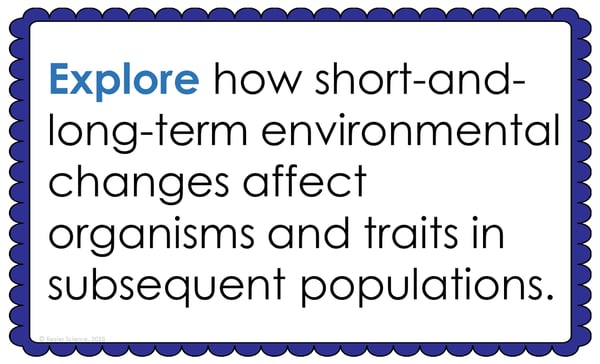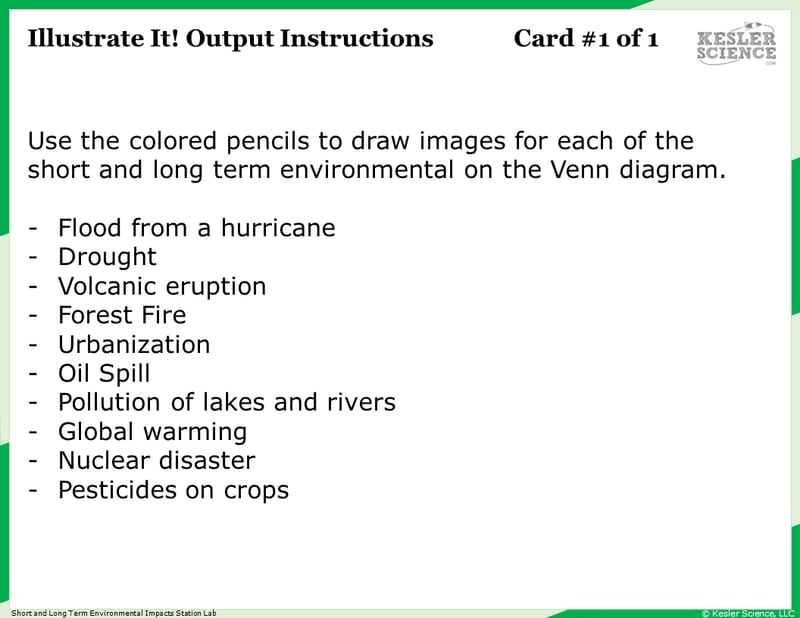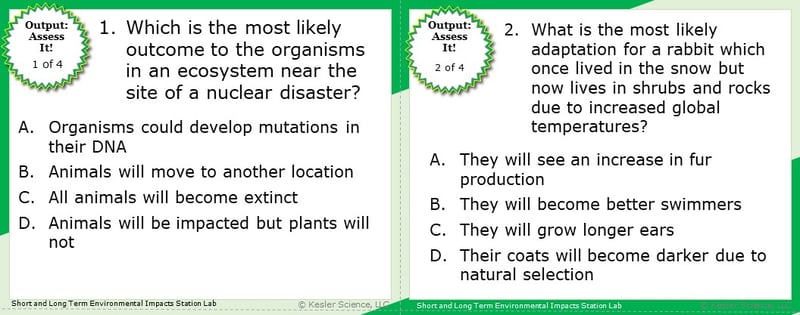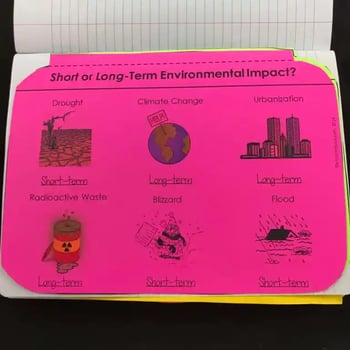Short-and-Long-Term Environmental Impacts Lesson Plan - A Complete Science Lesson Using the 5E Method of Instruction
By the end of this comprehensive lesson about the short-and-long-term impact of different things on the environment, students will explore how short-and-long-term environmental changes affect organisms and traits in subsequent populations. Each of our lessons is designed using the 5E method of instruction to ensure maximum comprehension by the students. This well-thought out unit does the heavy lifting, giving teachers easy-to-implement, highly engaging lesson plans.
This blog will walk you through each of the steps and activities from the Short-and-Long-Term Environmental Impacts 5E Lesson Plan.
ENGAGEMENT
Objective Introduction
At the beginning of the lesson, the class will do a Think-Pair-Share to discuss the objective.
Class Activity
The teacher will ask students to watch a video. The teacher will also tell the students about how the environment can be impacted negatively by both humans and natural means.
Student Activity
The teacher will pass out two Post-its to each student. Students will write down two disasters caused by either humans or nature. On the board, the teacher will create a T-chart with the headings “Humans” and “Nature.” Students will then come up and place their Post-its under the correct heading. Students will look at the results and reflect whether humans create more disasters or nature. Students will then take Post-its and identify if disasters listed can be categorized as either short-term or long-term environmental impacts.

Afterwards, the teacher will help to clear any misconceptions their students may have about short-and-long-term environmental impacts. A common but major misconception, for example, is that students usually don’t consider all the factors or know all the information they need to choose sides on environmental issues. Be sure to give them as much information as you can. These are great topics for debate.
Estimated Class Time for the Engagement: 20-30 minutes
EXPLORATION
This student-centered station lab is set up so students can begin to explore short and long term environmental impacts. Four of the stations are considered input stations where students are learning new information about natural selection, and four of the stations are output stations where students will be demonstrating their mastery of the input stations. Each of the stations is differentiated to challenge students using a different learning style. You can read more about how I set up the station labs here.
Watch It!
At this station, students will be watching a twelve minute video describing changes in the ecosystem. Students will then answer some questions relating to the video and record their answers on their lab station sheet. For example, describe how contrails impact the overall environment, list potential impacts to organisms during a global warming event, what are the impacts to the iguanas in the Galapagos during an El Niño event?
Read It!
This station will provide students with a one-page reading about drought impacts. In the reading, students will discover how ecosystems are affected by long periods of drought. They'll also ready about how a rain shortage not only impact organisms but the future flow of rainfall or the groundwater levels. There are four follow-up questions that the students will answer to demonstrate their comprehension of the reading material.
Explore It!
Students will be working in pairs to analyze certain impacts to environments. Students will analyze a set of cards and describe the impacts these disasters would have on the environment. Then, they will answer three questions.
Research It!
The research station will allow students to visit a National Geographic website that will educate them about adaptations. Students will then answer four questions based on the research they conducted. The research will guide students to find out what an adaptation is, what the differences between structural or behavioral adaptation are, describe specialization, and to describe co-adaptation.
Organize It!
The Organize It station allows your students to place cards describing short-term or long-term impacts to the environment into the appropriate category.
Illustrate It!
Your visual students will love this station. Students will draw images depicting short-and-long-term environmental changes on a Venn diagram.

Write It!
Students who can answer open-ended questions about the lab truly understand the concepts that are being taught. At this station, the students will be answering three questions to explain why is it important to study the short and long term effects that humans and nature can have on organisms in an ecosystem. Think about the animals in an arctic ecosystem and how would they adapt over time if global temperatures rise over several hundred years. Finally, to describe at least two ways in which nature can impact an ecosystem over a long period of time.
Assess It!
The Assess It station is where students will go to prove mastery over the concepts they learned in the lab. The questions are setup in a standardized format with multiple choice answers. Some questions students will be asked are: Which is the most likely outcome to the organisms in an ecosystem near the site of a nuclear disaster? What is the most likely adaptation for a rabbit which once in the snow but now lives in shrubs and rocks due to increased global temperatures? Which of the following will have the longest-term impact on organisms in an ecosystem? How would controlled forest fires impact the organisms in the ecosystem?

Challenge It! - Bonus Station
Early finishers and advanced students will love the extension activities in this station. Four activity choices offer them ways to expand their learning through mini-games and mini-projects.
Estimated Class Time for the Exploration: One or two 45-minute class periods
EXPLANATION
The explanation activities will become much more engaging for your class once they’ve completed the exploration station lab. During the explanation piece of the lesson, the teacher will be clearing up any misconceptions their students may have about how short and long term changes affect the environment with a variety of materials. These materials include on-level and modified versions of the interactive presentation (may be used individually or projected), anchor charts, and paper or digital interactive notebook activities. If you have students that need modified notes, the 5E lessons come equipped to help give every student access to the lesson.

Interactive notebook samples: Above-left is a digital INB activity slide; above-right is an example of the paper INB activities.
The students will also be interacting with their journals using INB templates for short-term or-long term impacts to the environment. Each INB activity is designed to help students compartmentalize information for a greater understanding of the concept. The organism relationships INB templates allow students to focus their notes on identifying disasters either short-term or long-term impacts.
Estimated Class Time for the Exploration: Two or three 45-minute class periods
ELABORATION
The elaboration section of the 5E method of instruction gives students choices that allow them to prove they’ve mastered the concepts behind the lesson. When students are given a choice, they’re much more enthusiastic and invested in the project than they are when their teachers choose their projects for them. There are a total of nine choices to demonstrate understanding of short and long term environmental impacts. A separate set of choices that offer more teacher support are also available for students that need them. Rubrics guide students to doing their best work and assist in grading.

Estimated Class Time for the Elaboration: Two or three 45-minute class periods (can also be used as an at-home project)
EVALUATION
The final piece of the 5E model is to evaluate your students' comprehension. Included in every 5E lesson is a homework assignment, assessment, and modified assessment. Research has shown that homework needs to be meaningful and applicable to real-world activities in order to be effective. When possible, I like to give open-ended assessments to truly gauge the student’s comprehension.
Estimated Class Time for the Elaboration: One 45-minute class period
DOWNLOAD THE FULL LESSON NOW
Download Over $100 in FREE Resources
For Middle School Science
Simply create a login below and gain immediate access to a selection of our Kesler Science product line worth $100 - for FREE. There's a full version of every product type! You'll also join tens of thousands of middle school science teachers who receive timely tips and strategies straight to their inbox.







